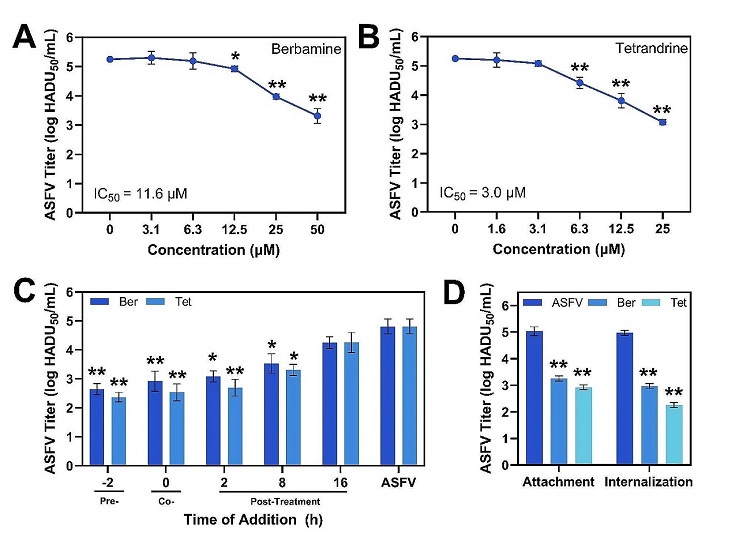Study Finds That The Phytochemicals Tetrandrine And Berbamine Are Potential Antivirals Against African Swine Fever Virus
Nikhil Prasad Fact checked by:Thailand Medical News Team May 08, 2024 11 months, 2 weeks, 4 days, 23 hours, 8 minutes ago
Herbs And Phytochemicals: The global swine industry faces a formidable foe in the form of African swine fever virus (ASFV), a highly contagious pathogen responsible for African swine fever (ASF). With mortality rates nearing 100%, ASFV outbreaks have severe economic repercussions, necessitating urgent interventions. In recent research conducted at Sungkyunkwan University in South Korea, a groundbreaking study explored the antiviral potential of natural compounds against ASFV. Among the compounds investigated, tetrandrine and berbamine emerged as promising dual-acting agents with both antiviral and anti-inflammatory properties.
 Antiviral activity of berbamine and tetrandrine against ASFV Arm/07 isolate in PAM cells. ASFV titer in cells exposed to different concentrations of (A) berbamine (3.1–50 µM) or (B) tetrandrine (1.6–25 µM). (C) Antiviral activity depending on the time of addition. (D) Effect of berbamine and tetrandrine on ASFV attachment to and internalization by PAM cells. The concentrations of berbamine and tetrandrine for the experiments in panels (C) and (D) were 50 µM and 25 µM, respectively. ASFV means virus-only control without compound addition while Ber and Tet denote berbamine and tetrandrine, respectively. Results represent the mean ± s.d. of three independent experiments (n = 3).
Understanding African Swine Fever Virus and Its Impact
Antiviral activity of berbamine and tetrandrine against ASFV Arm/07 isolate in PAM cells. ASFV titer in cells exposed to different concentrations of (A) berbamine (3.1–50 µM) or (B) tetrandrine (1.6–25 µM). (C) Antiviral activity depending on the time of addition. (D) Effect of berbamine and tetrandrine on ASFV attachment to and internalization by PAM cells. The concentrations of berbamine and tetrandrine for the experiments in panels (C) and (D) were 50 µM and 25 µM, respectively. ASFV means virus-only control without compound addition while Ber and Tet denote berbamine and tetrandrine, respectively. Results represent the mean ± s.d. of three independent experiments (n = 3).
Understanding African Swine Fever Virus and Its Impact
ASFV is characterized by its devastating impact on pig populations, leading to high fever, hemorrhagic symptoms, and ultimately death within a week of infection. The lack of effective vaccines or specific antiviral therapies exacerbates the challenge of controlling ASF outbreaks. Moreover, the significant elevation of pro-inflammatory cytokines in ASFV-infected pigs contributes to disease severity, highlighting the critical need for compounds that can inhibit viral replication while modulating the inflammatory response.
Exploring Natural Compounds for Antiviral Potential
The
Herbs And Phytochemicals study conducted at Sungkyunkwan University focused on screening a library of 297 natural compounds known for their anti-inflammatory properties. This approach aimed to identify compounds capable of inhibiting ASFV replication and reducing virus-induced cytopathic effect (CPE) in Vero cells, a commonly used cell line for viral research. Among the compounds tested, five showed notable inhibition of ASFV-induced CPE, with berbamine and tetrandrine demonstrating the highest levels of antiviral activity.
Validation of Antiviral Activity
Further experiments validated the antiviral efficacy of berbamine and tetrandrine. These compounds exhibited dose-dependent inhibition of ASFV replication in Vero cells, with tetrandrine showing particularly potent antiviral effects. Mechanistic studies revealed that berbamine and tetrandrine interfered
with early stages of ASFV infection, including viral attachment and internalization, thereby disrupting viral entry into host cells.
Antiviral Effects in Primary Target Cells
The investigation extended to porcine macrophages (PAMs), which are the primary target cells for ASFV replication in pigs. Berbamine and tetrandrine continued to demonstrate dose-dependent inhibition of ASFV infection in PAMs, underscoring their broad-spectrum antiviral activity. Importantly, these compounds disrupted viral entry mechanisms in PAMs, further confirming their consistent mode of action across different cell types and virus strains.
Anti-Inflammatory Properties
In addition to their antiviral effects, berbamine and tetrandrine exhibited potent anti-inflammatory activity in ASFV-infected PAMs. The compounds significantly reduced the production of pro-inflammatory cytokines such as TNF-α, IL-1β, and IL-6, which are key mediators of ASF pathogenesis. Notably, tetrandrine demonstrated sustained anti-inflammatory effects throughout the infection period, highlighting its potential in mitigating ASFV-induced inflammation.
Implications for ASFV Management
The dual-acting nature of berbamine and tetrandrine as antiviral and anti-inflammatory agents holds significant promise for ASFV management. These compounds not only inhibit viral replication but also modulate the host immune response, potentially reducing disease severity and mortality associated with ASFV infection. Moreover, their broad-spectrum antiviral activity suggests applicability against other porcine viruses, emphasizing their versatility in veterinary medicine.
Future Directions and Potential Applications
Further research is warranted to explore the therapeutic potential of berbamine and tetrandrine in vivo, including animal studies to assess their efficacy and safety profiles. Additionally, elucidating the precise mechanisms of action underlying their antiviral and anti-inflammatory effects will provide valuable insights for drug development. The discovery of tetrandrine and berbamine as dual-acting antivirals against ASFV opens new avenues for the development of preventive and therapeutic strategies, offering hope for better control and management of ASF outbreaks globally.
Conclusion
In conclusion, the study conducted at Sungkyunkwan University sheds light on the remarkable antiviral and anti-inflammatory properties of tetrandrine and berbamine against ASFV. These natural compounds represent promising candidates for combating ASFV infection and mitigating disease-associated inflammation. With further research and development, berbamine and tetrandrine could emerge as valuable tools in the arsenal against ASFV, benefiting both animal welfare and the global swine industry.
The study findings were published in the peer reviewed Virology Journal
https://virologyj.biomedcentral.com/articles/10.1186/s12985-024-02374-2
For the latest on
Herbs And Phytochemicals, keep on logging to Thailand Medical News.
